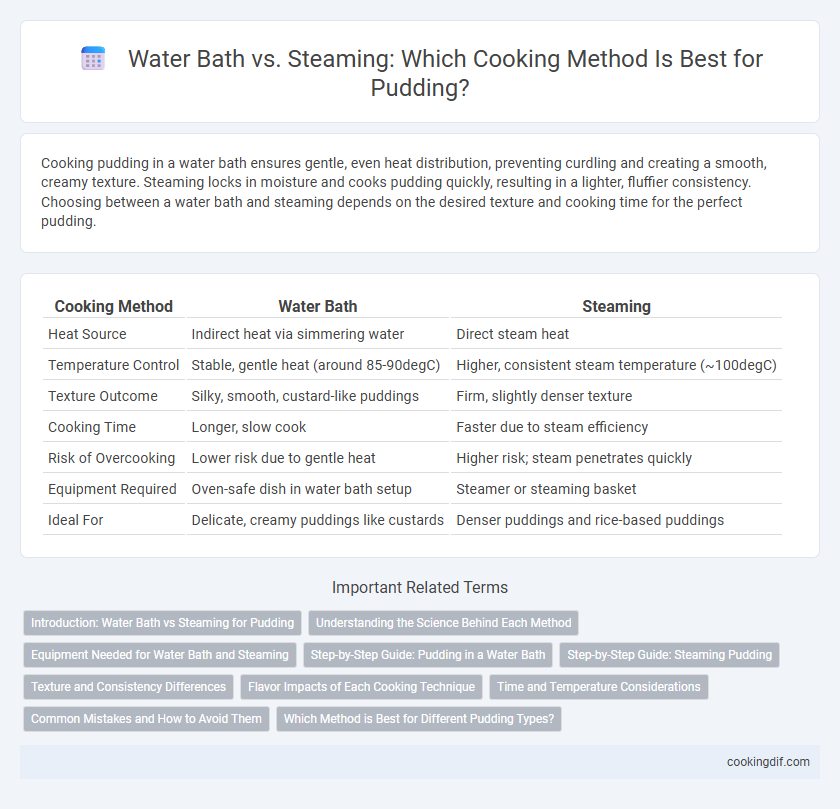Cooking pudding in a water bath ensures gentle, even heat distribution, preventing curdling and creating a smooth, creamy texture. Steaming locks in moisture and cooks pudding quickly, resulting in a lighter, fluffier consistency. Choosing between a water bath and steaming depends on the desired texture and cooking time for the perfect pudding.
Table of Comparison
| Cooking Method | Water Bath | Steaming |
|---|---|---|
| Heat Source | Indirect heat via simmering water | Direct steam heat |
| Temperature Control | Stable, gentle heat (around 85-90degC) | Higher, consistent steam temperature (~100degC) |
| Texture Outcome | Silky, smooth, custard-like puddings | Firm, slightly denser texture |
| Cooking Time | Longer, slow cook | Faster due to steam efficiency |
| Risk of Overcooking | Lower risk due to gentle heat | Higher risk; steam penetrates quickly |
| Equipment Required | Oven-safe dish in water bath setup | Steamer or steaming basket |
| Ideal For | Delicate, creamy puddings like custards | Denser puddings and rice-based puddings |
Introduction: Water Bath vs Steaming for Pudding
Water bath cooking provides gentle, even heat that prevents pudding from curdling and ensures a smooth, creamy texture by surrounding the dish with hot water. Steaming uses moist heat from boiling water vapor, which cooks pudding rapidly while maintaining moisture but can sometimes lead to uneven consistency if not carefully managed. Both methods enhance pudding quality by controlling temperature and moisture, crucial for achieving the desired delicate and tender dessert.
Understanding the Science Behind Each Method
Water bath cooking provides gentle, even heat that prevents curdling and cracks in delicate puddings by surrounding the dish with hot water, maintaining a consistent temperature. Steaming uses direct steam heat which cooks pudding more rapidly but may cause uneven texture or a firmer surface due to higher moisture and heat exposure. Understanding the thermal conductivity and moisture retention differences between water bath and steaming helps optimize pudding texture and prevents overcooking or drying.
Equipment Needed for Water Bath and Steaming
Water bath cooking requires a deep baking dish or roasting pan filled with hot water and an oven-proof dish to hold the pudding, ensuring even heat distribution and preventing curdling. Steaming necessitates a steamer basket or rack placed inside a pot with boiling water below, along with a tightly covered pudding basin to trap steam for gentle cooking. Both methods demand equipment that facilitates consistent, indirect heat to achieve the pudding's smooth, creamy texture.
Step-by-Step Guide: Pudding in a Water Bath
Cooking pudding in a water bath ensures gentle, even heat that prevents cracking and creates a smooth texture, unlike steaming, which can produce uneven cooking. Begin by preheating the oven and preparing a deep baking dish with hot water, filling it halfway for consistent heat distribution around the pudding mold. Place the pudding container in the water bath, carefully avoiding water inside the mold, then bake until the custard sets, usually 45-60 minutes depending on the recipe.
Step-by-Step Guide: Steaming Pudding
Steaming pudding involves placing the mixture in a heatproof container, covering it tightly with foil, and setting it in a pot with simmering water just below the rim of the container. Maintaining consistent heat and steam ensures gentle cooking, which results in a smooth and creamy texture without cracking. Regularly checking water levels and avoiding direct contact with boiling water prevents overheating and encourages even cooking throughout the pudding.
Texture and Consistency Differences
Water bath cooking creates a gentle, even heat that ensures puddings have a smooth, creamy texture with consistent firmness throughout. Steaming often results in a slightly spongier, more aerated pudding due to the direct steam contact, which can cause small air pockets and a lighter consistency. Choosing between these methods depends on the desired pudding texture: silky and dense with a water bath or light and fluffy with steaming.
Flavor Impacts of Each Cooking Technique
Water bath cooking gently surrounds pudding with consistent, moist heat, preserving delicate flavors and ensuring a creamy texture by preventing curdling or cracking. Steaming cooks pudding more rapidly and can infuse subtle moisture, but may lead to a less uniform texture and potentially dilute intricate flavor notes. The choice between these methods significantly influences the final flavor profile and mouthfeel of the pudding.
Time and Temperature Considerations
Water bath cooking maintains a steady temperature around 180degF to 200degF, ensuring even heat distribution and preventing overcooking, typically requiring 45 to 60 minutes for custard-based puddings. Steaming cooks puddings faster, often within 20 to 30 minutes, using higher temperatures near boiling point (212degF), but risks uneven texture if not carefully monitored. Precise time and temperature control in water baths yields smoother, creamier puddings, while steaming offers quicker results with a firmer consistency.
Common Mistakes and How to Avoid Them
Using a water bath or steaming for pudding cooking can lead to common mistakes such as uneven cooking or water seeping into the pudding. Ensuring the container is tightly sealed and maintaining consistent temperature helps avoid these issues and achieve a smooth, creamy texture. Avoid placing the pudding directly in boiling water to prevent curdling or cracking, and always monitor the water level to keep it from boiling dry.
Which Method is Best for Different Pudding Types?
Water bath cooking creates a gentle, even heat ideal for delicate custard puddings like creme caramel, preventing curdling and ensuring smooth texture. Steaming offers a faster, moist-heat method suited for firmer puddings such as rice or bread puddings, maintaining moisture without overcooking. Choosing the best technique depends on the pudding's consistency and ingredient sensitivity, with water bath preferred for creamy types and steaming for denser varieties.
Water bath vs steaming for cooking method Infographic

 cookingdif.com
cookingdif.com